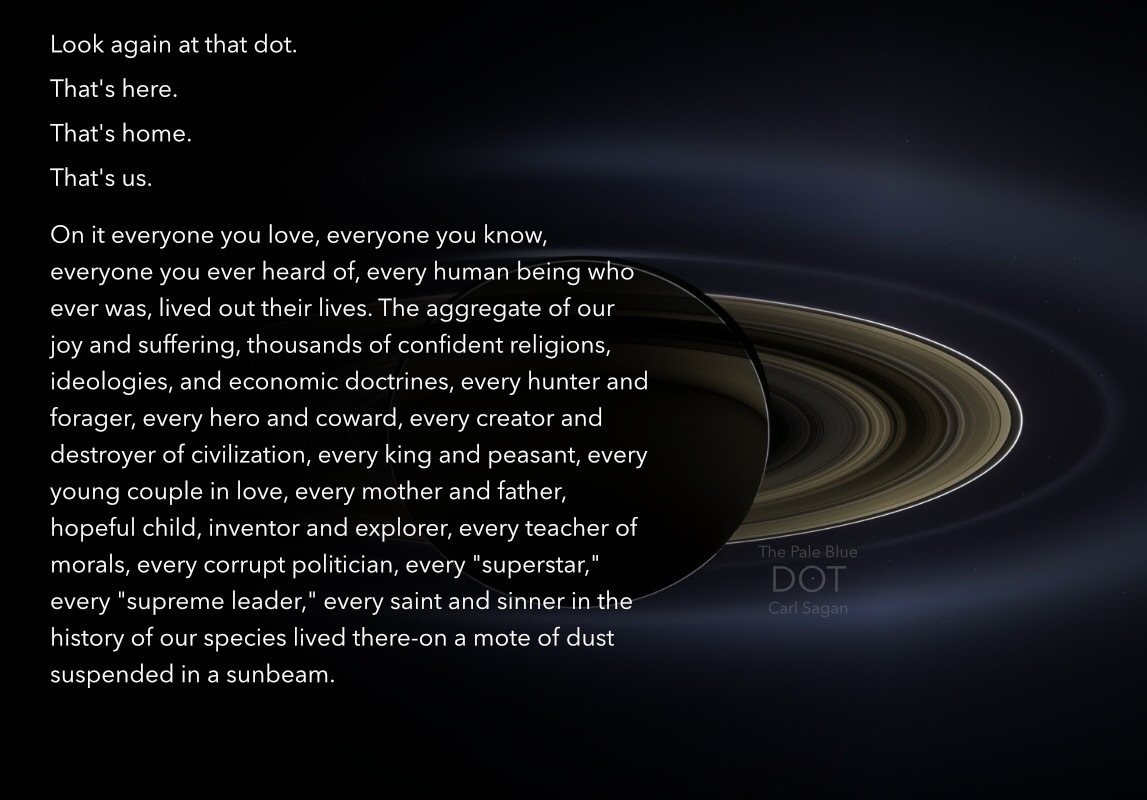Humanity
How do you define self?
Back around 1991 I co-organized and participated in a Council of all beings, a gathering created to help humans connect and empathize with the world around them. In our case the council was based upon the book Thinking Like a Mountain.
Whether it was the book or the gathering, what I took to be the foundation of both, remains with me 30+ years later: I am not just an individual human with a name. In fact, this human is trillions of bacteria, millions to billions of fungi, hundreds of trillions of viruses. We all contain multitudes. We are all an ecosystem. But we then also exist within the larger planetary ecosystem. Billions of humans sharing a planet with every other non-human species. And our “individual” wellbeing is connected to the wellbeing of the larger ecosystems in which we exist.
Those of us in the global north have focused on our individual selves and the nuclear family if we have one. Certainly this is true for those of us in the US. The cultures of the global north encourage us to focus on living a particular kind of (high energy, high consumption) life which ignores the fundamental importance and reality of our larger selves. The result of this disconnection is that humans are actively destroying the larger whole of which we are a part. Simply put, without healthy, balanced Earth ecosystems humans will cease to exist. This is an obvious truth and yet we ignore it every day. We pretend that we can exist without the rest.
From the Invocation written by John Seed:
We call upon the spirit of evolution, the miraculous force that inspires rocks and dust to weave themselves into biology. You have stood by us for millions and billions of years — do not forsake us now. Empower us and awaken in us pure and dazzling creativity. You that can turn scales into feathers, seawater to blood, caterpillars to butterflies, metamorphose our species, awaken in us the powers that we need to survive the present crisis and evolve into more aeons of our solar journey.
Awaken in us a sense of who we truly are: tiny ephemeral blossoms on the Tree of Life. Make the purposes and destiny of that tree our own purpose and destiny.
Fill each of us with love for our true Self, which includes all of the creatures and plants and landscapes of the world. Fill us with a powerful urge for the well-being and continual unfolding of this Self.
It may well be that the survival of our species will require such a shift of understanding and, following from that, a shift on our way of being in the world with our fellow species. And, for that matter, perhaps equally important, a shift in how humans relate to fellow humans. As it stands in 2024 we continue to waste energy a resources in war and competition with one another. We would do far better in cooperation. One human species working together with no loss of resources to conflict.
It would be a very different kind of world for all species on the planet.
Over at Mastodon Jason shared this article about living a simple life. The post offers up some helpful, worthwhile suggestions about being more thoughtful in life choices in terms of the usual practice of keeping up appearances, consumption-based living, etc.
I looked at a few other posts from the site which offered similar good advice. But it is the packaging of minimalism and simple living that has become a bit of a meme on the internet. And while such sites might serve as an introduction to questioning consumerism as a way of life they often have something to sell. I wasn’t too surprised to see that, indeed, these folks offer a paid course. Even the simple life has a price. 😉
But yes, it’s increasingly obvious that our modern way of life is putting strains on our mental and physical health as well as on the ecosystems of the planet. In the developed nations the top 10% have built a way of life based on hyper consumption of resources which requires constant work and a focus on income. For many the vision of the “American Dream” is playing out as something else entirely.
We’re living in a time of persistent crises. The climate crisis serves as the background and it alone represents an existential crisis. But on top of that there are many others that surface as a result of the world we’ve built. The “simple life” and “minimalism” offer up a glimpse of something else. They hint at a calmer, quieter life with reoriented values like time spent or experiences a relationships rather than stuff. On the surface this sounds good because want to feel better, we want relief from the crises of modern life.
But let’s not just go for relief. Too often our drive is our physical and/or mental comfort and often that means a quick fix or band aid. So, let’s not just stop at the notion that our problem is too much stuff. Yes, acquisition of too much stuff is a problem but really, it’s also a symptom of a deeper cultural problem.
Let’s dig deeper.
Capitalism is the basis of modern, western nations. For decades it’s been sold as congruent with democracy, almost as though it is the other half of democratic society. It’s been assumed by many to be normal, natural and the way that economy should function. Certainly this is the commonly held view in the United States. But at the base of capitalism is insecurity, the never ending drive for increased profit through increased growth and consumption. These are fundamental, foundational to the “American Dream”.
The problem with simple living and minimalism as commonly discussed is that they serve is a temporary balm but leave us with problems. And so we just continue in long crisis. We experience it personally as perpetual longing for the unknown thing that we think will help us feel more secure, happier, content. It’s always there over the horizon. It’s to be found in documents like the US Declaration of Independence: “Life, liberty and the pursuit of happiness.”
Happiness. Dare I say that perhaps a part of our problem is our focus on our happiness? It seems normal enough, to want to be happy and to search for what makes us happy. But happiness is ephemeral. It’s not a permanent state. And we live in a time and culture when it’s a fairly common message that what brings us happiness is the purchase of that next thing. Or, even, that next new experience. It might be a concert, movie or a trip. But no matter what we consume, the “happiness” is fleeting and within hours or days, we’re onto the next thing we want.
My suggestion is that we consider shifting our focus away from our pursuit of happiness. And don’t get me wrong, it’s okay to be happy, to experience joy. But I would suggest that we need to go deeper in our search. That it would be more helpful and meaningful to ask other questions. To begin, what is our purpose as humans. How can we contribute to the well being of not just our families but our communities? Will our life on the planet leave a it degraded or even severely degraded to the degree that future life will suffer?
I’m not going to claim to know all of the questions we should be asking or to have the answers. But, rather, that we should be asking more of ourselves than we have been.
I’d like this to be a series of posts because it’s the kind of exploration that can and should branch off into side explorations. For example, what is the result of a culture that encourages a focus on the nuclear family as many of the wealthy nations do?
Thinking living simply, there are practical considerations of how we think of exercise and physical labor in a time when many work in offices. Which is a subject can then branch off into the tools we use and how they may be measured in terms of longevity, repairability, carbon footprint, and requirements for use.
There’s a lot to explore and I’m planning follow-ups.
Solidarity.
I woke up this morning thinking about the word solidarity. There was the time of my life when I thought about it every single day. A kind of daily meditation.
An awareness of shared interests, objectives, standards, and sympathies creating a psychological sense of unity of groups or classes…
It refers to the ties in a society that bind people together as one.
I long for a world where humans care for one another regardless of their differences. And where humans care for their planet as a whole.
Planetary solidarity.
Sunday morning reflection on our moment in the cosmos
On a clear night, we are blessed with a wonderful view of a star filled sky. Tonight, just before turning in, I stopped to stair up at the glittering patterns above me, and the vastness of heavens that our tiny planet sits in. I find something quite calming and humbling viewing that site.
It really is calming and humbling. We’re so, so tiny in the vastness of it all. With just our eyes we can only see perhaps 6,000 stars in our night sky. But our galaxy contains billions! And then to consider the vast space between each star, that the photons from those distant stars have traveled for thousands of years only to end their journey when they strike the eye of a tiny little mammal on a tiny little planet.
The more I’ve learned of the cosmos the more insignificant I’ve felt within it. But in a good way. To feel in size and temporality like a rain drop in a brief moment falling to the Earth. And the Earth, in the cosmos, just one planet around one star amonst 200 billion other stars in our galaxy alone. And to think there are 200 billion other galaxies? We are infinitesimal. Insignificant and yet significant.
Several years ago I was in the habit a spending lot of time with a telescope looking at stars, nebulae, galaxies and our nearby planetary neighbors. It was a kind of meditation on the above, trying to understand, or, to just begin to grasp, the reality of our existence in the vastness of time and space. Those long nights in the dark, looking up at stars thousands of light years away and the faint galaxies that were millions of light years away, letting my mind imagine the many possible worlds that might exist. To consider the possibility of other life forms, some possibly intelligent also looking up into the vastness of space just as I was, brought a strange mix of emotions. My mind would slowly vacillate from a kind of deep peace and sense of belonging even as I felt and acknowledged the indifference of the cosmos. That my life was the single momentary flicker of a summertime firefly and so too is that of humanity, just a moment. Night after night I both rested and grappled with these thoughts and the realizations that drifted from them.
We humans have only existed on this planet for 300,000 years (in our “modern form”). Just a blink of an eye in Earth history and even less in the history of the cosmos. For most of our existence it might have been difficult for a off-world visitor to even know humans were here. We fit into our landscape quietly. Just thousands slowly growing into millions. And then of course things changed. Our industrial civilization with its various conflicts and social forms has only a few hundred years. For all of our intelligence, we’re not very good at living our lives in the larger context. For the most part we’re not able to hold in our minds and daily lives a reverence for our moment in this larger continuum. As animals we react to what’s in front of us right now. It would seem our brains, in terms of evolutionary biology, are tuned to exist only in the moment as it exists in the much smaller context of our lived time and space. It makes sense for short term survival.
And yet, that moment-to-moment instinct to survive works against us. In some ways, not all that different from a bird or a squirrel, we focus on the immediacy of our days. The human dramas that play out in front of us in our homes, schools, and neighborhoods. And not content with those physical, “in real life” connections, we’ve created ways to interact via small glass screens with people all around our planet. Connecting but not connecting. War and conflict continue despite our increased ability to communicate. Planetary-scale problems, most notably climate change, deepen into crisis as we fail to grasp the imbalance we’ve imposed upon the delicate and fragile biosphere.
And so here we are. Tiny and alone on a planet that has, over 4.5 billion years evolved an incredibly diverse life support system. As a species we have simultaneously come to understand the complexity of our biosphere even as we’ve increased our exploitation of it. And so it is that with more than 8 billion of us, we are slowly coming to grasp the full scope of our crises. We have pushed our life support system to the edge. And yet, as I type these words, just outside my window everything seems normal. I hear a variety of birds going abut their lives, singing to one another in the forest. My impression at this moment is that everything is okay. There is no obvious crisis to be seen in my world in this moment. It would be easy to say that this planet is resilient, that it has been here for a long time and will go on.
And you know what? It will. It will. But we have changed it. Our planet is now caught up in a process from which there is no turning back. We are in it. My morning thoughts are of both the special significance of life on our planet, of the long evolution our complex biosphere but also of our place in the universe. Whatever happens on our planet in the next few months and years, whether we rise to the challenge of changing course, the planet will be here in a hundred years. A thousand years. Despite the havoc we have unleashed, life here will evolve to adapt. Much will be lost. In this tiny, tiny corner of the galaxy a species of animal that called itself Homo sapiens lived for a short time. To some degree came to know itself and its place in the larger cosmos. And then it flickered out. By its own hand or some other larger, cosmic event.
I struggle daily trying to come to terms with what we’ve done. But when I look up into the vastness of the night sky, at the thousands of nearby stars or the distant galaxies millions of light years away, I settle into a kind of understanding, an acknowledgment of the moment. As many others have said, we are made of star stuff and we’ll return to that one way or another. The universe doesn’t care. Whatever happens here, today, our planet will continue to spin on its axis as it revolves around the sun which will continue its journey around the galaxy. Our sun and solar system take 200+ million years to make one full orbit around the galactic center. For perspective, the last time our sun was in this place in its orbit the dinosaurs roamed the planet. They lasted millions of years.
I’m not sure how long humans last but this is our moment.
The length of a human life is around 80 years. You might get 100 if you’re lucky. The universe is about 13.7 billion years old. The vast difference between a human lifespan and the age of the universe can be difficult to grasp — even the words we use in attempting to describe it (like “vast”) are comically insufficient.
To help us visualize what a difference of eight orders of magnitude might look like, Wylie Overstreet and Alex Gorosh have created a scale model of time in the Mojave Desert, from the Big Bang to the present day.
Cofounder of Greenpeace and writer of the Deep Green column Rex Weyler helps us transcend the idea that we can fix the environment – or anything else – so we can finally learn to participate as members of a living world.
An excellent discussion between Rex Weyler and Douglass Rushkoff on the current episode of the Team Human Podcast.
Extreme Living
Several weeks ago I shared the below video on a family thread and one of the comments I received was:
Takes an extreme mindset to live this type of “one with nature lifestyle”.
Watching the video I’d had the opposite reaction. My reaction was that it felt natural, healthy, fun, beautiful. I mulled over that response, “that it requires an extreme mindset” and I suppose that for many that live and grow up in “Western/developed” nations would agree. Those living in this moment expect comfort in the form of modern convenience.
But, just to flip it… thinking about humans on earth… Based on an estimated homo sapiens origin of 300,000 years ago, we lived on Earth for 299,500 of those years in ways much like we see in the video. And it’s not really been until the last 100 years that many people (in western nations) moved out of agriculture and into cities. In a blink of an eye, we’ve come to view the natural way that humans lived on the planet for 99% of our existence as extreme.
What we have to day has only existed as normal for a very short period of time and won’t likely persist for more than another 50 years. And I see no evidence that it should. It’s a life out of balance with not just the planet but even with other humans who have had access to far less during this short, destructive experiment that began with the industrial revolution.
Bully
Why is the president of the United States cyberbullying a 16-year-old girl?
And now Trump has a new target for his bullying: Greta Thunberg, the 16-year-old environmental activist. Thunberg seems to be really making Trump upset, without meaning to. She doesn’t fit into any of his ideas of how girls are supposed to act. She isn’t trying to be a contestant in one of his beauty pageants. She’s too busy trying to get world leaders like him to do something about the climate crisis. She’s too occupied by giving speeches at places like the UN – where Trump was laughed at, when he gave a speech in 2018, and Thunberg was met with respect, despite slamming the entire body for “misleading” the public with inadequate emission-reduction pledges.In the last couple of weeks, while Trump was seemingly mocked by his peers at the Nato summit in London, and impeachment hearings against him began, Thunberg was named Time’s person of the year, an honor Trump reportedly wanted. And so he did what he always seems to do, on Twitter, when he’s upset: he lashed out by accusing the person upsetting him of the very things he’s feeling, or is guilty of.
50 Years after landing on the moon: Thoughts on a the potential of humanity
I turned 50 years old on June 5 so I was alive for the moon landing but just 6 weeks old. But in thinking about that accomplishment and the 50 years that have passed, my lifetime thus far, I am struck by two things. First, humans can do amazing things when they work together. Second, humans are often not very good at working together.
It’s often said as common knowledge that humans went to the moon primarily as a result of the Cold War between the U.S. and the U.S.S.R. It was that competition and division that drove each country. In 2019 humans we find ourselves in a similar state of fracture and division. In the U.S. we seem to be caught in a cultural, political and economic war with ourselves. Internationally we can see that humans, divided into political entities called countries, also continue to fight with one another.
[caption id=“attachment_1461” width=“4158” height=“4166”]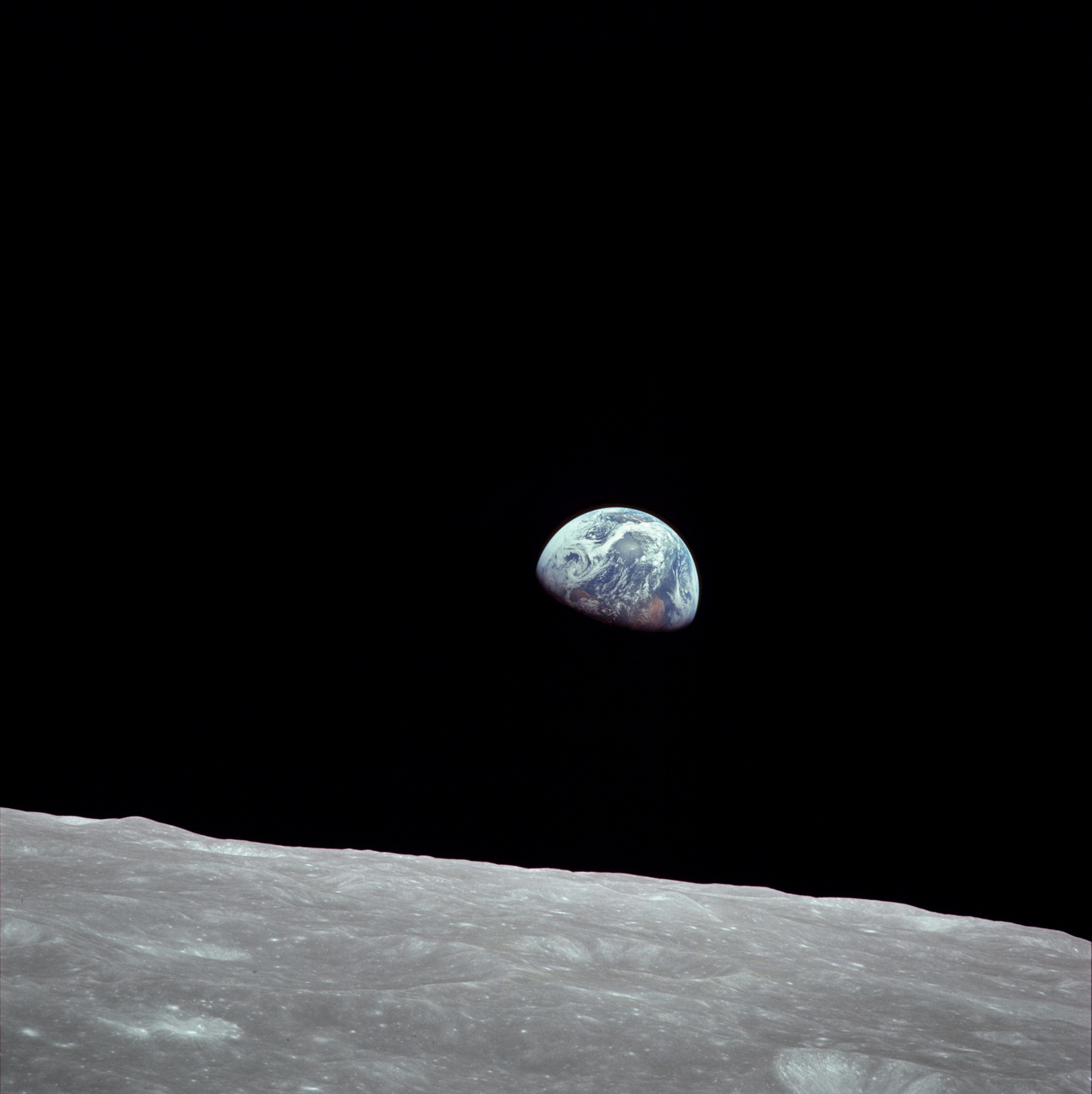 Earthrise[/caption]
Earthrise[/caption]
On this morning of the anniversary of humans landing on the moon I took a walk with my dogs. It just so happens that the moon, in it’s waning phase, was visible in the western sky. I looked and imagined those men 50 years ago. I imagined looking back at Earth from their perspective on the moon. This fragile planet that we call home. We’re not very good at seeing ourselves as humans. As a species we share a home with one another and with countless other species but we don’t view ourselves as a family or as a community. We still fight with one another based upon our skin color, our language, our beliefs or any possible difference we might have. We seem to be stuck in a way of thinking and being that emphasizes the negatives of diversity rather than celebrate the symphony of the whole that might be possible.
As I think about humans in 2019 I wonder about the next 50 years. Will we continue to fight one another? Are we doomed to struggle in this self-inflicted process? We show amazing promise when we work with one another rather than against one another. We achieve amazing things when we collaborate as allies. We have before us many challenges, difficult problems which we have ourselves created. I’d like to Imagine, as John Lennon did, a world in which humans go beyond the gravity of our past, that force that binds us to conflict and division. What might we achieve as a common community working together rather than against one another. It seems like a beautiful, if distant possibility.
Only Radical Transformation...
The “Great Dying” Has Begun. Only Transforming the Economy Can Stop It.
Life is once again headed for total collapse. While coverage of last week’s major Intergovernmental Science-Policy Platform on Biodiversity and Ecosystem Services (IPBES) report on biodiversity loss rightly played up the dire numbers — an estimated 1 million species gone by 2050 — what’s truly remarkable are the solutions the authors offer in response. Ditching the timid pragmatism of technocrats, these scientists are calling for nothing less than the total transformation of the global economy. Producing for profit has failed us, they say, and failed the planet. We need a new system.
Only “transformative change” can stop massive species loss, according to the report’s conclusion. That means overhauling the global economy to prioritize human well-being and environmental sustainability rather than the pursuit of profit. “We’re not addressing the underlying causes of biodiversity loss, which is the way we organize economies, production and consumption patterns, our institutions, and our rules,” says Ingrid Visseren-Hamakers, associate professor of environmental science and policy at George Mason University and a coordinating lead author of the IPBES report. “We need to transform the sheer fabric of our society to become more sustainable.”
Today’s great dying is happening faster than ever before, and its causes are clear: breakneck development, fossil-fueled global warming, industrial pollution, single-crop agriculture. Complex as these processes are, they point to a common culprit: A growth-based economic system bent on wringing cash from nature has exploited the planet’s ecosystems beyond what they can bear. Now, Earth’s fragile life-support system is entering a death spiral that threatens human existence and which no one is prepared to stop.— Read on onezero.medium.com/the-great-dying-has-begun-only-transforming-the-economy-can-stop-it-4eadd8f7ccf8
Species Extinction Accelerating
This. Yes, this says it well.
Alexandra Petri writing for the Washington Post about the recent UN Report: Nature’s Dangerous Decline ‘Unprecedented’; Species Extinction Rates ‘Accelerating’,
Just admit it! You don’t care about other species!
Look, let’s abandon this charade, all right?I understand: You do not give a ringtailed lemur’s posterior about the majority of life on earth. I fully get it. Believe me, I barely give a carp about it, and some of it is my family. Just — respect me enough to admit it, okay?
For years I have come to you with news that the prairie chicken is not doing so well, and you have furrowed your brow and made concerned sounds. But — the prairie chicken does no better. I am sure you intend to do something about the prairie chicken, but “doing something about the prairie chicken” has slid somewhere on your priorities list below “doing nothing about the prairie chicken" and “forming strong, detailed opinions about the coffee cup that briefly appeared in a single shot of ‘Game of Thrones.’” And that’s fine! I mean, it’s not fine, but it’s between you and your God. Just, admit it, so we can stop wasting time.
I feel like the hardest part of my job right now as a scientist is how you pretend you care about other living beings (apart from dogs and cats, the dunking otter, the new dunking otter, or the occasional octopus who has on account of his exceptional gifts risen from straitened circumstances, pulling himself up by eight bootstraps). To save the rich and glorious tapestry of species that makes life possible on earth, there is nothing you would not do, except alter the way you live in even the slightest bit or be mildly inconvenienced for a very brief time. That is the sense I’m getting? I guess I understand why it is an important element of your self-image that you care about such things, but — look, you are not fooling anyone.
The U.S. nightmare
What the fuck is happening in the United States. This is a fucking nightmare.
Youngest migrants held in ‘tender age’ shelters
Trump administration officials have been sending babies and other young children forcibly separated from their parents at the U.S.-Mexico border to at least three “tender age” shelters in South Texas, The Associated Press has learned.Lawyers and medical providers who have visited the Rio Grande Valley shelters described play rooms of crying preschool-age children in crisis. The government also plans to open a fourth shelter to house hundreds of young migrant children in Houston, where city leaders denounced the move Tuesday.
Celebrating 40 years of Voyager
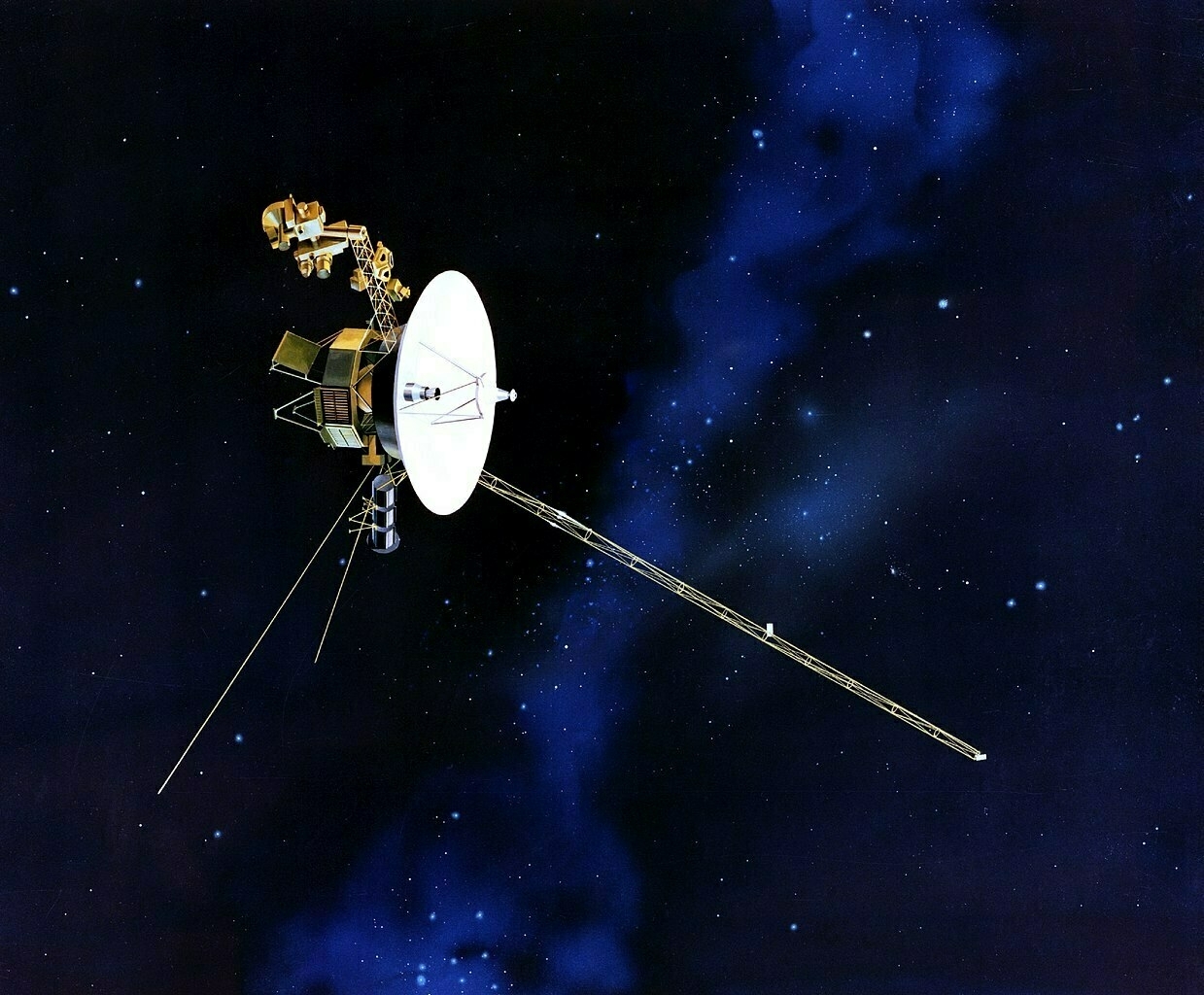
We are the only species that, due to it’s technological abilities, destroys habitat at unprecedented scale. How is it that a species which is supposedly so intelligent can cause such destruction to itself and it’s home? How is it that we can be precise in our engineering and yet so sloppy in our human interactions?
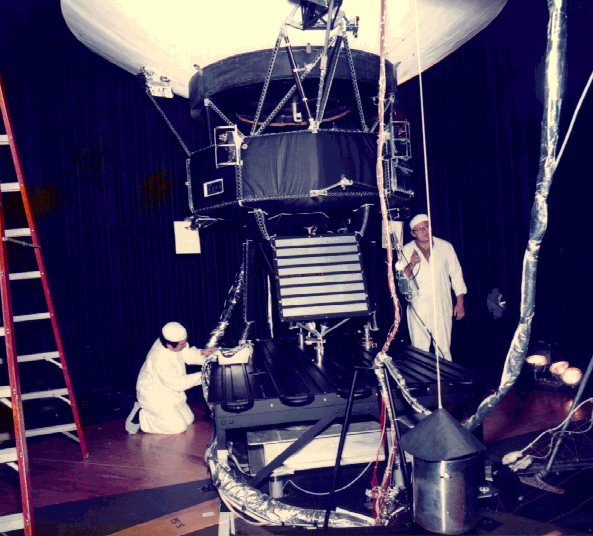
It helps to remember that we are primates. Which is to say, we’re just really smart, differently evolved Hominini, a member of the family of great apes. Perhaps from this context, it’s a bit easier to understand our persistent fallibility. As individuals and a collective, we live in fallibility though we are intelligent enough to deeply alter our environment. From fire to coal to oil to the atom; from simple tools to complex tools to earth moving machines to computers to robots exploring our solar system. We humans are constantly in a state of exploration and often destruction. Our evolutionary “success” seems to exist, though, on the finest of edges. With our ever increasing population (7.5 billion at this moment) dependent on a complex food system which is itself based on the availability of fossil fuels and a stable, semi-predictable climate.
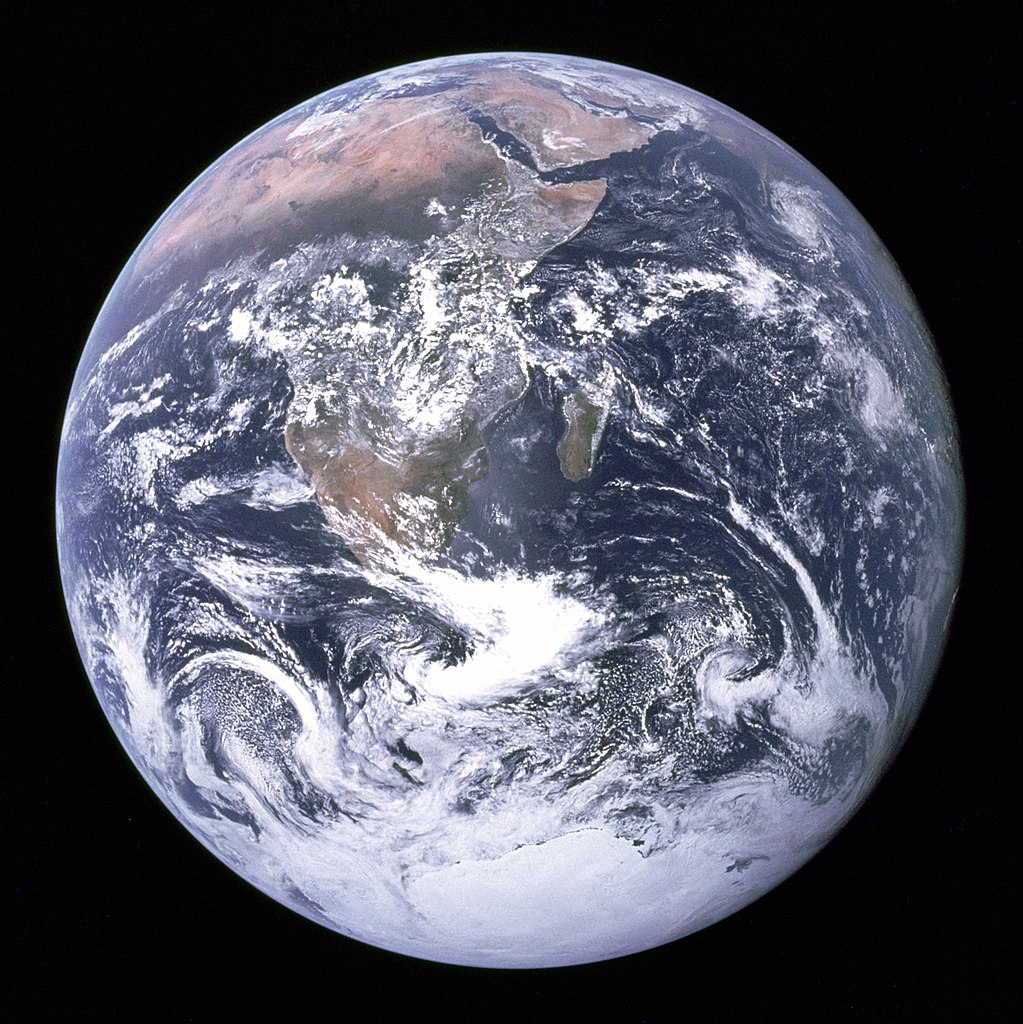
We are simultaneously capable of extended, deep reasoning as well as irrationality and superstition. In so many ways we, as individuals and as social systems, seem to reside in perpetual conflict. We often use the scientific method to wondrous and beneficial effect. Other times we use it to great disaster. Sometimes we push forward too fast, not knowing the results that may emerge. The full repercussions of our actions are often not known but even when they are predicted we fail to heed our own warnings.
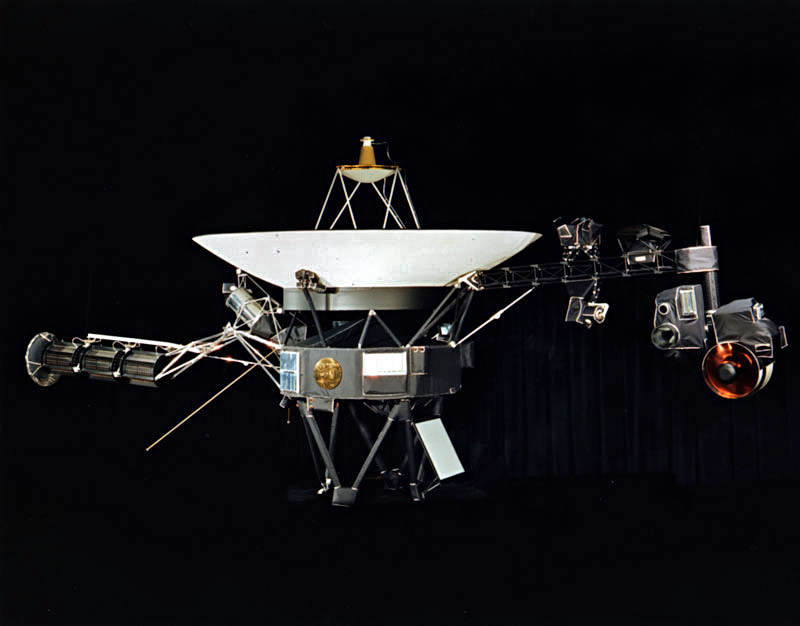
Our many societies, complex tapestries of history, culture, politics, ecology, science, art and economy, are often at odds with one another as well as with themselves. In so many ways the Voyager spacecraft are the perfect representatives of humanity. They embody our struggle with fallibility and our development of science as a method and a tool in response to that fallibility. We have developed and used these two spacecraft to explore our universe and to convey something of ourselves to it. At our very best we are explorers and communicators and sometimes our many voices are brought together in a shared expression of our common humanity.

The Golden Records, our attempt to reach out into the unknown, to share something our tiny world, were created to carry our voices and our story as well as the sounds and images of our Earth. From bird song to whale song, Mozart to Blind Willie Johnson, to the sound of a human heart beating. In addition to a wide variety of audio he record included imagery ranging from illustrations of our solar system to DNA to daily life on our planet. Carl Sagan chaired the committee that spent a year selecting and then compiling the content. Included were the words of then U.S. president, Jimmy Carter:
"This is a present from a small, distant world, a token of our sounds, our science, our images, our music, our thoughts and our feelings. We are attempting to survive our time so we may live into yours."
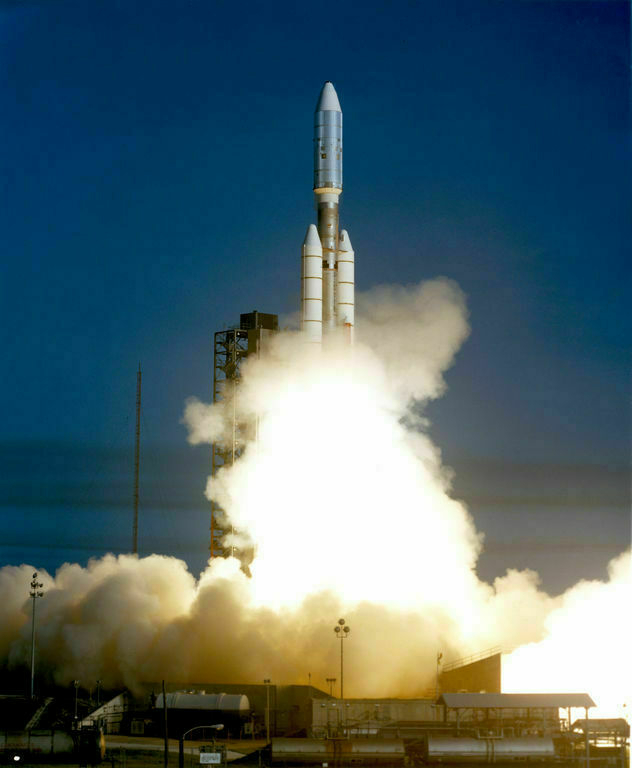
Of course, the spacecraft are far more than carriers for the Golden Records. In fact, the records were really intended to be the 2nd part of the mission, the purpose of the spacecraft after they no longer have the ability to transmit data back to us. The 1st part of their mission was, of course, the collection of data about our solar system a mission they are still performing even as they have ventured beyond the solar system.
With less computing power than a cell phone, they have, over the course of their mission, deepened our understanding our our solar system immensely. Beginning with Jupiter, and Saturn and then later Uranus and Neptune.
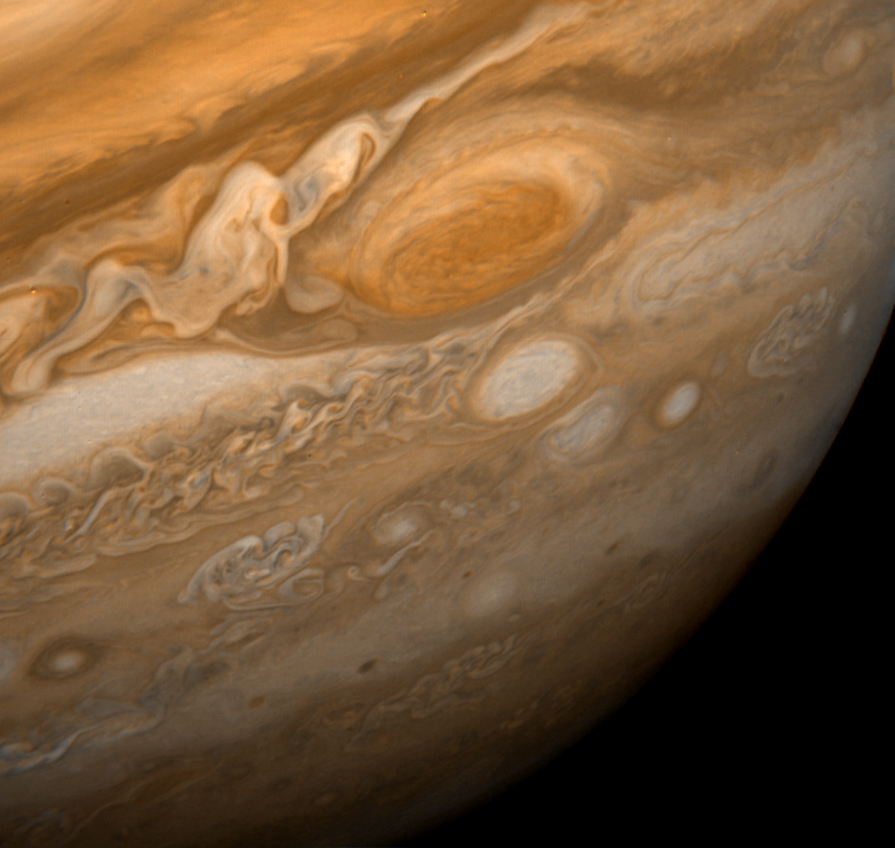
The first planetary encounter of the mission was Jupiter which began when Voyager 1 began taking photos in January 1979 with the closest approach on March 5 and final photos being taken of the planet and moons in April 1979. One of the highlights of this part of the mission was the discovery of volcanic activity on the moon of Io. It was the first time active volcanoes had been observed on another body within our solar system. Voyager’s mission at Jupiter was not the first encounter or the last. There have been 9 thus far.
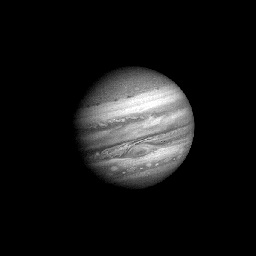 An animated view of Jupiter taken with photos taken every 10 hours.
An animated view of Jupiter taken with photos taken every 10 hours.
As Voyager was taking it’s photos of Jupiter it was also getting a gravity assist from the planet. Which is to say, it borrowed energy from the planet’s gravitation to change it’s trajectory and give it a boost to the next destination of its journey: Saturn. The Saturn encounter began November 1980 with closest approach on November 12, 1980 when it came within 77,000 miles (124,000 km). There have been a total of 4 spacecraft encounters with Saturn. Three of those were flybys and one, the Cassini-Huygens spacecraft, an extended mission which has been ongoing since 2004 and which will end in September 2017.
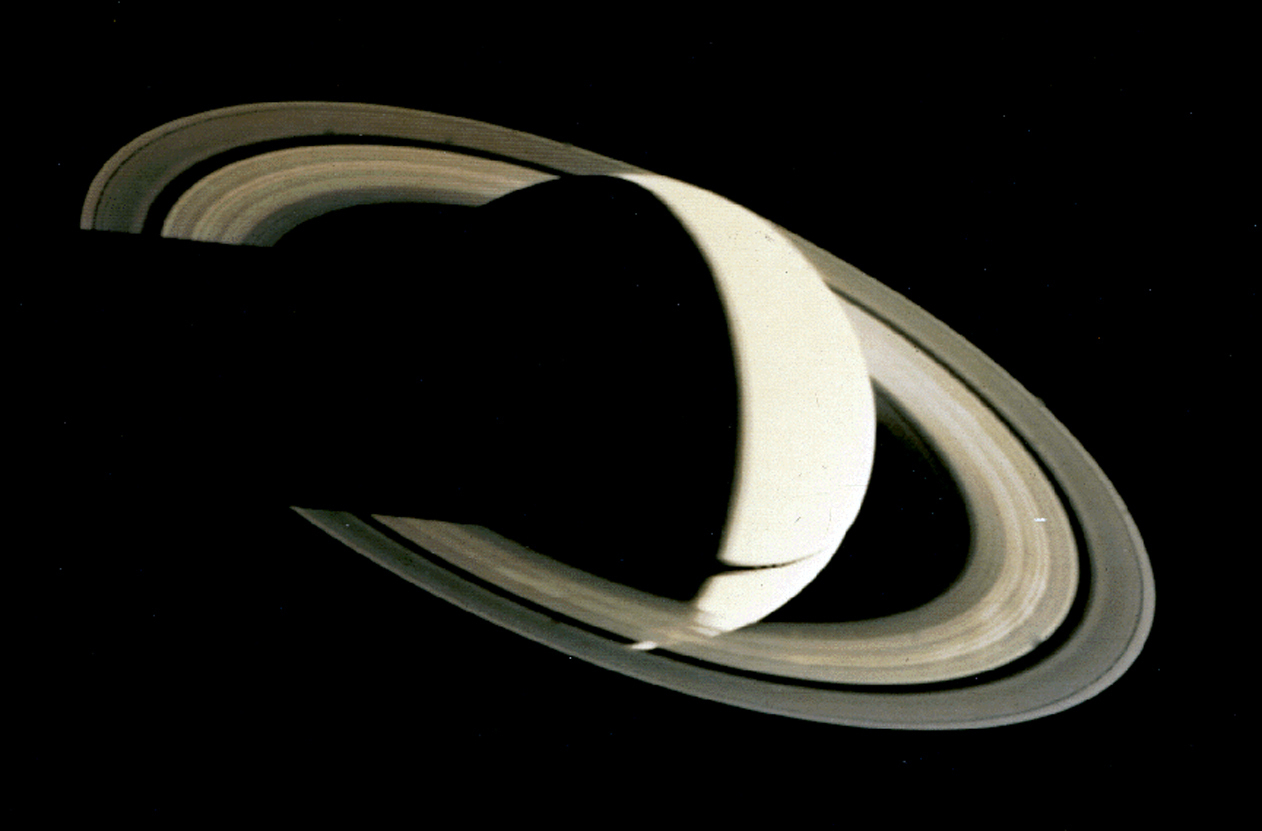
After Saturn, Voyager went on to Uranus and Neptune. Thanks to Carl Sagan, Voyager had one last photographic mission. The last photographs taken were a family portrait of our solar system. On February 14, 1990, at a distance of 6 billion kilometers from Earth, Voyager captured a mosaic of 60 photos including 6 planets: Jupiter, Earth, Venus, Saturn, Uranus and Neptune. It is from this series of images that the famous Pale Blue Dot photograph was taken. In the image the Earth is just a tiny blueish-white speck seen in a brownish band of light on the right side of the image.
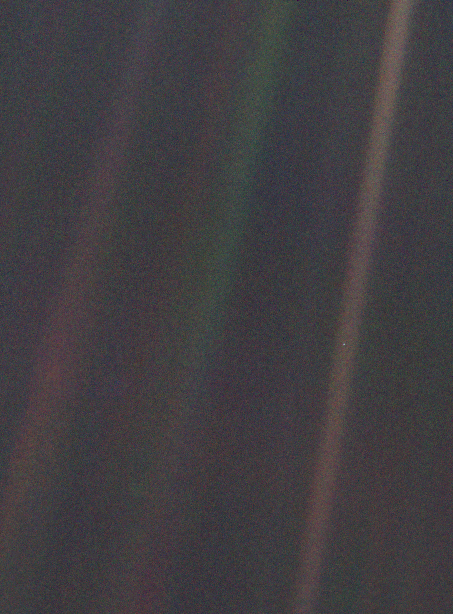
"We succeeded in taking that picture, and, if you look at it, you see a dot. That's here. That's home. That's us. On it, everyone you ever heard of, every human being who ever lived, lived out their lives. The aggregate of all our joys and sufferings, thousands of confident religions, ideologies and economic doctrines, every hunter and forager, every hero and coward, every creator and destroyer of civilizations, every king and peasant, every young couple in love, every hopeful child, every mother and father, every inventor and explorer, every teacher of morals, every corrupt politician, every superstar, every supreme leader, every saint and sinner in the history of our species, lived there – on a mote of dust, suspended in a sunbeam.The Earth is a very small stage in a vast cosmic arena. Think of the rivers of blood spilled by all those generals and emperors so that in glory and in triumph they could become the momentary masters of a fraction of a dot. Think of the endless cruelties visited by the inhabitants of one corner of the dot on scarcely distinguishable inhabitants of some other corner of the dot. How frequent their misunderstandings, how eager they are to kill one another, how fervent their hatreds. Our posturings, our imagined self-importance, the delusion that we have some privileged position in the universe, are challenged by this point of pale light.
[…] To my mind, there is perhaps no better demonstration of the folly of human conceits than this distant image of our tiny world. To me, it underscores our responsibility to deal more kindly and compassionately with one another and to preserve and cherish that pale blue dot, the only home we’ve ever known." — Carl Sagan, speech at Cornell University, October 13, 1994
To celebrate the 40 year anniversary PBS has created a fantastic website and documentary, The Farthest: Voyager in Space. It is a truly wonderful documentary and I was moved to tears more than once while watching it. Stream it via their app or the above website. I’ll likely be watching it again. The website is beautifully done with a wealth of imagery, text and live display of the current Voyager mission time and distance from Earth.
Voyager at 40
A great thread by @justinhendrix over on Twitter:
The solar eclipse Monday is set to overshadow another significant event for space nerds like me. Tomorrow, August 20th, is a special day.August 20th is the 40th anniversary of the 1977 launch of @NSFVoyager2, the first of two Voyager probes to explore the outer planets.
Its sister probe, Voyager 1, was launched 16 days later. These two probes represent one of humanity’s most extraordinary achievements.
Voyager 1 is nearly 13 billion miles from Earth; it takes a ray of light more than 19 hours to travel from here to its position.
Voyager 2 is nearly 11 billion miles and 16 light hours away. 5 years ago Voyager 1 entered interstellar space, on 25 August 2012.
Incredibly, both spacecraft are still sending scientific information about their surroundings through the Deep Space Network.
In the late 1960s that NASA determined a once-every–176 year alignment would allow a spacecraft to to visit all four outer planets.
Voyager delivered the first single frame photo of the Earth and the Moon together from space. twitter.com/justinhen…
The probes carried radioisotope thermoelectric generators powered by plutonium, and carry an array of scientific instruments. twitter.com/justinhen…
The computers aboard the Voyager probes each have 69.63 kilobytes of memory in total. That’s about enough to store one average .jpg.
The probes used assembly languages such as FORTRAN. Recently the Voyager program hired a new FORTRAN programmer. www.popularmechanics.com/space/a17…–1-voyager–2-retiring-engineer/
The probes visited all the giant outer planets, including Jupiter, Saturn, Uranus and Neptune. They made numerous important discoveries.
For instance, erupting volcanoes on Jupiter’s moon Io, the first evidence of volcanic activity elsewhere in the solar system.
The volcanos on Io were discovered by a JPL Voyager imaging scientist named Linda Moribito Kelly. www.planetary.org/blogs/gue…
Voyager discovered an ocean beneath the icy crust of Jupiter’s moon Europa, waves and fine structure in Saturn’s icy rings, Neptune’s…
Great Dark Spot and 1,600 kilometer-per-hour winds, geysers erupting from the polar cap Neptune’s moon Triton, and eventually…
The termination shock where supersonic solar wind slows down, forming the final frontier of the solar system. ibex.swri.edu/students/…
You can see many of the images that the Voyagers took during their trek through the outer planets here: www.jpl.nasa.gov/voyager/g…
Jupiter. twitter.com/justinhen…
Saturn. twitter.com/justinhen…
Uranus. twitter.com/justinhen…
Neptune. twitter.com/justinhen…
And the famous Pale Blue Dot photo, which inspired Carl Sagan’s speech, which we should all listen to & consider www.youtube.com/watch
The Voyagers also famously carry a Golden Record, which carries the sounds of earth into space- Sagan’s idea. www.npr.org/2017/08/1…
Blind Willie Johnson’s ‘Dark Was the Night, Cold Was the Ground’ is one of the songs now in interstellar space www.youtube.com/watch
The Voyagers represent the best of humanity. The best scientific thinking, engineering, ambition, curiosity, passion, arts and culture.
We’d do well at this moment, 40 years hence, to look at the legacy of these probes, and consider what we can learn from their journey.
It’s more than the sum of their scientific discoveries. They explore the universe, but they also tell us something about ourselves.
Our best selves. Voyager is the best of humanity. We need to remember the aspiration to be our best selves, to advance the species.
So enjoy the eclipse, but spare a moment tomorrow at 10:29 AM Eastern to remember the launch of @NSFVoyager2, a great human achievement.
Here is an excellent hour on the history of Voyager from the BBC. h/t @acinonnap www.bbc.co.uk/programme…
Pale Blue Dot
With all of the craziness of the past couple of days (and really, the months since DT took office) it’s good to get some perspective with Carl Sagan.
The original image was taken in 1990 at Sagan’s request. I used the new image taken July 19, 2013 by the Cassini spacecraft in an event called “The Day the Earth Smiled”. Look closely at DOT and you’ll find the Earth at the center.
Story behind original image taken in 1990 at Penny4Nasa.
Just Breath
The world is all upside down these days. It’s a good time for deep breaths and time under the stars. Last night I spent a good long while looking at Saturn and a few of it’s moons. Then I spent some time looking at the Lagoon Nebula.
Apple and the environment
If you’ve read this blog for long you may have picked up that I’m a bit of an Apple fan. But it’s also true that I have, since around 1990, I have oriented the way I live my life around the question, “Is this good for the health of the Earth?” Those that know me would probably agree with the suggestion that I’m a bit extreme in that regard. The way I look at it is that it is, fundamentally, a question lived ethics and survival. What we do everyday impacts not only our future survival but the survival of countless other species with which we share the planet. Our choices thus far have been leading us to the extinction of other species and quite possibly our own. Our time on this planet does have an expiration date. One day humans will no longer exist on this planet. That’s a given. But will we end our time here prematurely due to poor behavior? Increasingly it looks as though we will.
I have long argued (as many have) that capitalism is incompatible with the longterm health of the planet. As an economic system it is focused on profit and specifically short-term profit. Corporations have demonstrated time and time again that they don’t do well when it concerns the environment and questions of human social justice. In the past ten years Apple has begun to demonstrate that it is possible continue making a profit even as it undergoes a dramatic shift in it’s social and environmental impact from a negative to a positive. Apple isn’t just minimizing its negative impact but is attempting and succeeding at creating a significant positive impact.
In recent years as it makes these changes it has made an effort to communicate to the public what it is doing. On the face of it it’s pretty easy to dismiss as the usual greenwashing that many companies engage in when they care about that aspect of how they appear to the public. In other words, marketing. But here’s the thing, Apple has gone so far in changing the way it operates that it no longer appears to be trying to convince the public that it is a good corporate “citizen”. They have seemingly made it a part of their mission to set the bar of conduct at a new level. This is a sustained effort to shift the fundamentals of the company from one that prioritizes profit to one which puts environmental impact on an equal footing.
In the lead-up to Earth Day 2017 we’ve seen a push by Apple to share what it’s been doing in these areas. In past years they have done the same but with each passing year as the scope of their commitment deepens it seems to be a shift from corporate marketing to one in which Apple sees a “teachable moment” and is educating the public not for it’s own benefit but for the public good. They are setting an example not just for corporations but even for citizens and governments. They aren’t just meeting the too-low requirements and goals set out by governments. They are exceeding them and raising the bar and not just by a little. And then they are saying to the world, do better. Do much better.
A day or so ago John Gruber of Daring Fireball and The Talk Show published an interview with Lisa Jackson, Apple’s VP of Environmental Policy. I remember when Lisa Jackson moved over to Apple having served 4 years as head of the EPA under Obama. At the time I just figured, oh, the usual high-level corporate/government revolving door. I didn’t pay much attention to her. But listening to that interview I can only say that I am really impressed. She’s a fantastic asset to Apple as well as an excellent STEM role model who also addresses the connection between STEM and our social and ecological problems and needs. I’ve listened to it twice and might give it a third go. She offers some fascinating details about how Apple operates in relation to resources.
As an activist who protested Nike in the late 90s for it’s overseas labor policies I was keenly aware that Apple was having it’s own labor issues in the early 2000s (and probably before). I began paying attention then to both the labor and environmental practices of my favorite technology company with some hope that they would “Think Different” in their dealings with the world around them. They have not disappointed. While progress was made when Jobs was at the helm their move towards greater social and environmental responsibility really increased when Tim Cook took over. The focus on the social and environmental responsibility has intensified greatly over the past 5 years. This interview is an excellent summary of those changes. But what is truly breathtaking is the scope and depth to which they have gone.
It’s easy these days to become mired in a mix of hopelessness, despair, frustration and disgust. Our political system seems equal parts corrupt, inept, and circus. On the issue of climate change the U.S. has proven largely ineffectual and confused. From the public to government to business, we’ve made little progress at far too slow a rate. It seems very likely that we are past the point of no return and that all there is to do now is adapt and attempt to minimize what now seems to be inevitable. But I listen to this interview and not only am I inspired but I’m embarrassed that it is a company… a capitalist enterprise that is actually leading the way, that is setting the best possible example not only for other companies but for citizens. As someone who has long considered himself an activist (of sorts) I suddenly feel a bit ashamed of my despair. That might not be exactly it or quite the best way to put it but it’s close.
Also, Apple has put together four videos for Earth Day 2017. Good stuff.
And yet another bit of Apple and the environment bit of news, Macworld reports that Apple will return heat generated by data center to warm up homes:
Apple is building a new data center in Denmark, and it has some interesting ideas on how to power the data center with renewable energy, while also giving back to the community.Excess heat generated by the data center will be captured and returned to the local district’s heating system, which will warm up homes in the community.
This is just one example of many that illustrates the scope of commitment that Apple is making to this effort. This is exactly the sort of project that Lisa Jackson is describing in the above linked interview with John Gruber.
Last but not least, Apple is set to move into it’s new headquarters, Apple Park. Much work is still being done but April was to be the month that employees started moving over. To say that I’m impressed with Apple Park would be a huge understatement. From native and edible landscaping to the heating and cooling to the local energy production, it is, by all accounts, the standard for large scale green architecture and landscaping.
Eternity
I stretch forward
Pushing through time.
Eternity.
A solar system long gone.
A sun burned dim.
Humans long now just a memory.
In space.
Lives once deemed important.
Faded.
Moments now echoes in time.
Precarious
As is my usual routine I took my dog Cosmo out for our walk to the mailbox yesterday. Along the way I had a thought about the precariousness of our existence on Earth. We live in this sort of illusion as our daily life is wrapped in an assumption of stability. For the most part our human brains encounter the same environment everyday. Most of us wake up in the morning and are active during the day. The light from our sun scatters in our atmosphere, heating and lighting and otherwise presenting a world around us that seems stable. Somedays are cloudy, others sunny, often a mix of the two. As we go about our days we see a mix of human and non-human species, natural and human environments. We eat and breath, work, play, and talk.

But our life on this planet exists on the thinnest of onion skins. The biosphere of our planet, the zone in which all life happens is remarkably thin. While the actual thickness of the biosphere is not easily measured it generally falls within a range of 6.5 miles. At the highest we have birds flying as high as 1.1 mile and at the depth we have fish 5.2 miles below the water. There are examples of higher flying birds and deeper dwelling organisms but they are exceptions to the general. The diameter of the earth is 7,918 miles. The radius is 3,959 miles. Almost all life on our planet lives on the outer 6.5 miles of that.
As an amateur astronomer I’ve spent a good bit of time viewing and contemplating space and distance. For all of the beauty of the stars in the night sky, space is mostly empty. The space between stars is vast. The space between galaxies even more so. If we just turn our attention to our own solar system and what exists here well, again, it’s mostly empty space. Our Sun makes up 99.86% of the matter in our solar system. Our Earth, though it is the densest planet in the solar system, is only the tiniest proportion of the mass of our solar system. It barely registers. On the scale of our solar system our Earth is merely a tiny point separated from the sun and other planets by vast distances. To get a sense of it watch this amazing video by Wylie Overstreet in which three guys drove out to the desert of Nevada with a to-scale model to demonstrate the spacing of our solar system.
Our lived experience, our world, is just a precarious, thin layer on what amounts to a very tiny planet. On a clear, dark night I can lookup and see several thousand stars with my naked eyes. In remote locations such as mine there is little light pollution and the atmosphere disappears. It is in this star-lit darkness that I can begin to experience the Earth as a space ship of sorts. It really is a living space ship. In our orbit around the sun we move through space at 67,000 miles per hour. But remember, our solar system is also moving around the center of the Milky Way galaxy at 490,000 miles per hour. Of course we don’t see it or feel it directly but it is happening nonetheless.
Life on Earth is precarious. It’s stability is not permanent. Our sense of day-to-day continuity is something we’re used to and something we assume will continue. I’d suggest that if more people had a better sense of how it all works, had a better sense of just how thin the envelope of safety is, perhaps they might be more inclined to take seriously the warning of science regarding climate change, habitat loss and other aspects of biosphere stability. It’s too late to stop much of what we’ve set in motion but if we don’t make real change very soon we will experience the worst case scenarios.
It’s up to us
So, Trump won the 2016 election. Yikes. Many are rightly concerned with what he and the Republican controlled congress will do. So many issues, far too many to cover here. No, this is a post about climate change because that’s one that affects us all and it’s the one that in the near and long term is causing significant damage to the ecosystems of our planet to the degree that our very survival is in question. For far, far too long people have looked to government for solutions. To technology and products for easy or even fun fixes. This must stop.
I think the real question is when will we all become the solution for the planet? I understand that laws can help, that federal funding can help. But each and every day every person on the planet makes choices, mostly going with the flow and the flow is harmful. This is especially true in the U.S. and other affluent nations where consumption of energy and goods have been far higher. It’s easier to go with the flow and so we do. We drive. We turn the thermostat to whatever makes us most comfortable. We buy food shipped in from across the country or world. We freeze our food, we refrigerate it. We buy new phones, tablets, and computers, big screen televisions, and huge houses to fill. New cars, new clothes, and the list goes on.
What. Are. We. Waiting. For? Must we really be told by the government how to behave? Forced? I get that corporations need such enforcement. The vast majority of them behave very badly in regards to the environment. But each of us? We can choose to do better. Every day we can choose to harm less but by and large we choose to harm more because its our way of life. Our way of life is based on consumption, comfort and convenience all of which are based on the burning of fossil fuels. That’s it. There’s no magic involved in fixing this.
DO LESS. CONSUME LESS. BE LESS COMFORTABLE. ACCEPT INCONVENIENCE.
A list of the things we can do everyday regardless of who is president:
Do the bare minimum in climate control of your home. If it’s cold outside be as cold inside as you can be. It was 30° today at sunrise. My tiny home was 50° because my heat was off. I was cozy because I was wearing warm clothes and was covered with blankets, a dog and a cat. I got up put on a jacket and made some coffee and oatmeal. In the summer I do the same. I do the best I can to deal with the heat. Eventually I turn on the AC just as this winter I will use heat. But I make a choice to cover up and to wear layers. I don’t assume it’s my right to crank my heat up to 70 or 75 or any other temperature.
Don’t drive unless you must. I work from home so it’s easy. I go to town once a week or less. I only go if I must and when I do I combine all my errands. If I forget something it waits until the next trip. When I lived in Memphis I walked and used a bike as much as possible. I did use a car when I needed to… and sometimes when it was convenient. But that’s when I made the wrong choice. Everyday our highways are full of cars most of which have only one person in them. That’s the wrong choice.
Take a train, not a plane. This is a big one. We fly the globe with little consideration of the climate change impact. If you’ve flown in the past year can you also say how much carbon your flight produced? Was it even on your radar? For some it may be but I’d guess that for most it never enters the equation. Why not? If we must travel we should travel by train as it is FAR more efficient.
Buy less. Buy used. Share. Make do. This is pretty straight forward. You don’t buy stuff unless you must. When you do buy you buy used if you can. Borrow first. Fix first. If you replace something and it is still useable (computers and gadgets especially) make sure it goes somewhere where it will be reused. Whether you sell it or donate it, be responsible for it because it’s not waste. It’s a resource with lots of energy bound up in it.
Reuse and recycle as much as possible. I stopped buying trash bags a long time ago. I use canvas bags for shopping but occasionally get the plastic bags that I use for trash. I throw away one of those plastic shopping bags filled with trash once every 2–3 weeks. Almost everything is recycled. When I do visit the dumpster it is always full of mostly recyclable materials that others are too lazy to recycle. Most “trash” isn’t trash at all.
Eat less meat, eat local food if possible. Food takes energy to produce and transport. Some takes more energy, beef and other raised livestock especially. This one can get complicated and probably requires it’s own post.
Do less in a general way. People are always on the go. Stop. Take a nap. Read a book. Take a walk. Just stay out of your car.
Last but not least, choose not to have children. This is another biggy that probably could do with it’s own post. Each human requires a lifetime of resources. There are 7+billion of us on the planet. We probably need to reduce that by lowering the birth rate.
This is just a partial list that covers some of the most obvious choices that also happen to have the most impact. I’ve had a thought in the past day that it would be great if we had a social media that combined aspects of FB, Instagram, Twitter etc but which was focused on making such changes. A website that offered an opportunity to commit to the most important, impactful choices that individuals can make. Such a site would include ways to share and document solutions and efforts. We should celebrate the effort and the change. Our social media hashtags should be about how we’re saving the planet. Our selfies should show our gardens and our produce. Our latest home improvement share should demonstrate practical repairs, re-uses and re-purposes. I think our use of social media has, to now, largely been about ego and status. That should change. It should be about supporting one another’s efforts to make the changes we must make if we are to survive.
Many of us were surprised by the election of 2016. Many upset. There’s much fear about the policies that will be enacted. The fears are valid. But much of the work we have to do would have existed regardless of the election. Especially in regards to the environment, much of what can happen, much of what needs to happen, much of what must happen, is in our own hands. We cannot wait for government to force us. We cannot wait for convenient technological fixes. We cannot wait. Me and you. We each make our choices. We must make better choices for ourselves and encourage others in our lives to do the same.

